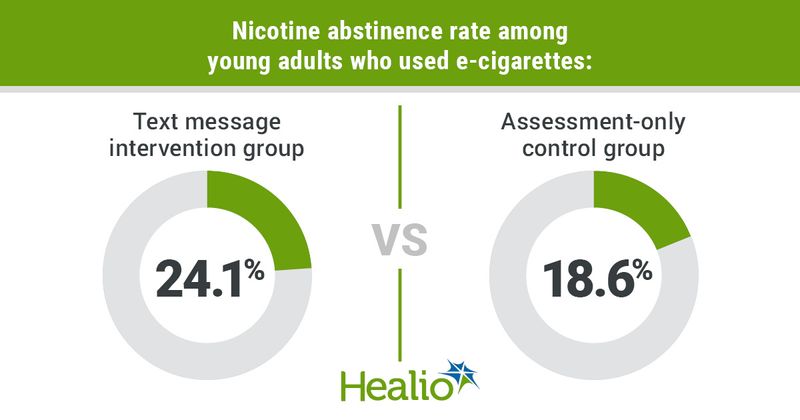Text message intervention effective in reducing e-cigarette use
Young adults who received daily text messages as part of an e-cigarette cessation intervention reported higher rates of nicotine abstinence compared with a control group, according to results of a randomized clinical trial.
“Mobile phone ownership is ubiquitous among [young adults], and text messaging is easy to use, discreet, anonymous, and a preferred communication modality in this age group,” Amanda L. Graham, PhD, the chief of innovations at Truth Initiative, a nonprofit that aims to reduce nicotine use, and an adjunct professor of medicine at the Mayo Clinic College of Medicine and Science, and colleagues wrote. “Text messaging has also been shown to be an effective intervention strategy for smoking cessation.”

Graham and colleagues conducted a parallel, two-group, double-blind, individually randomized controlled trial of 2,588 adults aged 18 to 24 years (mean age, 20.4 years; 48.4% men; 83.4% white; 10.6% Hispanic; 19% sexual minority) who indicated an interest in quitting e-cigarettes.
All participants received monthly text messages assessing e-cigarette use. The researchers randomly assigned 1,304 participants to also receive the “This is Quitting” intervention, an automated text message program that incorporates social support and cognitive and behavioral coping skills training. According to the Truth Initiative’s website, the intervention is free and anonymous. Participants receive at least one text message per day that is tailored to their age and desired quit date. They can also text “COPE,” “STRESS,” “SLIP” or “MORE” to receive additional messages, according to the website.

“The program is written in first-person, positioned as a nonjudgmental, supportive friend to the user,” Graham told Healio Primary Care.
Many of the messages were submitted by other users, according to Graham. She said that they “are designed to bolster confidence,” “contain strategies from other young people” and “suggest concrete evidence-based skills and strategies users can practice,” such as practicing out loud in a mirror how to decline a vaporizer if offered.
The remaining 1,284 participants in the study were assigned to an “assessment-only” control group, the researchers wrote.
Graham and colleagues followed up with the participants at 1 month and 7 months after randomization. The primary outcome measure was self-reported 30-day point prevalence abstinence at 7 months.
At baseline, 93.1% of participants reported vaping daily and 82.3% of participants reported vaping within 30 minutes of waking. At 7 months, the abstinence rate was 24.1% in the intervention group and 18.6% in the control group (OR = 1.39; 95% CI, 1.15-1.68).
“The strong and consistent results from this trial demonstrate that this program is providing the right support and information to help young people quit e-cigarettes,” Graham said. “Importantly for the field, the results of the clinical trial establish an effectiveness benchmark and begin to fill an important gap in understanding how to help young people quit e-cigarettes.”
The next steps in the research “will be to conduct a series of secondary analyses to understand HOW This is Quitting increased abstinence rates,” Graham said.
“We suspect that three elements are likely at play: text messages are daily reminders of an initial commitment to quit that helps keep people engaged in the quitting process; knowing that other young people are quitting and have quit successfully boosts confidence; and tips and strategies on how to quit provide the actual skills young people need to break free from nicotine addiction,” she said.
References:
- Graham AL, et al. JAMA Intern Med. 2021;doi:10.1001/jamainternmed.2021.1793.
- Truth Initiative. This is Quitting. Accessed May 17, 2021. Available at: https://truthinitiative.org/thisisquitting.
- Truth Initiative. Who We Are. Accessed May 17, 2021. Available at: https://truthinitiative.org/who-we-are.

